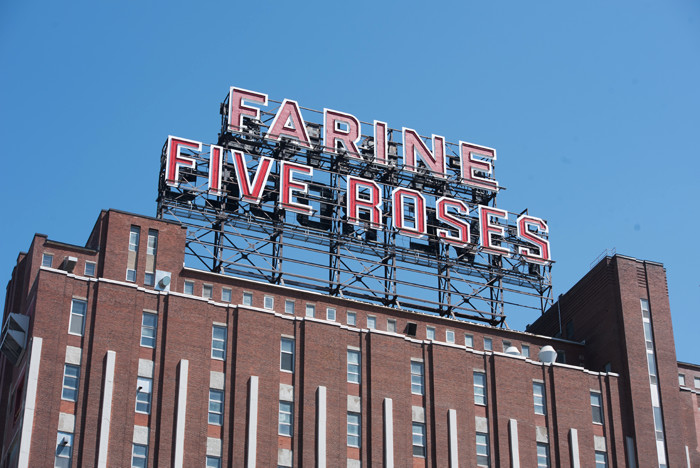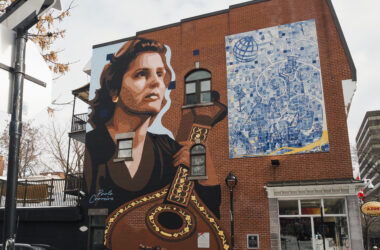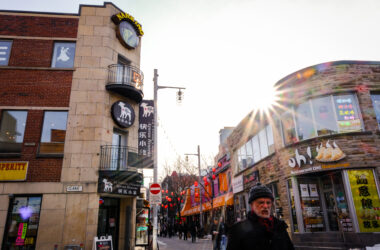Since 1948, the glowing Farine Five Roses sign has been a fixture of the Montreal skyline: A series of neon letters that greets cars approaching from the Southwest District. What began as a simple advertisement for Ogilvie flour, later Five Roses, has become a prominent part of Montreal’s iconography and one of its most treasured landmarks. The sign spotlights the forgotten industrial past of the district surrounding the Lachine canal, which, at one point, held the largest concentration of industrial buildings in Canada. At the same time, the sign has been the subject of hundreds of photographs taken by tourists and locals alike and has become a Montreal landmark. An ongoing art project by Concordia Communications Professor Matt Soar and his collaborators highlights the past and present of this enduring city icon.
Throughout its existence, the sign has gone through just two major changes, no small feat considering the heft of the 15-foot steel letters. After Quebec’s Bill 101 passed in 1977, limiting non-French words on signage across the province, owners eliminated the English translation ‘Flour’ formerly placed below ‘Farine / Five Roses.’ The ‘Five Roses’ line was permitted because of Bill 101’s exception for English brand names. After the brand changed ownership in 2007, the sign was turned off, seemingly for good. Then, resistance rose on social media and was soon backed by advocacy groups including Heritage Montreal. The public response inspired Soar to start a blog to crystallize the effort and preserve the landmark.
Soar—who also founded Logo Cities, which keeps record of the many high-rise logos that mark the Montreal skyline—examines the relationship between hypercommercialism and signage. Hypercommercialism is the idea that advertizing increasingly seeps into every area of our daily lives. In gathering and researching advertisements for his work, Soar discovered the remarkable social and personal power of the iconography that saturates urban environments.
“What became abundantly clear was not only do we have hypercommercialism […], but when people see, commune with, and touch old signs, it sparks memories,” Soar said. “They act as lightning rods for local memories.”
With this in mind, Soar expanded the reach of his project, which first emerged as the “Save Farine Five Roses” blog, to chronicle the drama surrounding the sign’s possible removal. His new objective was to preserve the landmark in the public’s memory. For example, his photoshopped anagrams of the 15 letters, called ‘Farinagrams,’ generated more interest than simple news aggregation. Though Smuckers, the new owner of the Five Roses brand, ultimately relented to public pressure and committed to restoring and maintaining the sign at significant cost months later, the blog remains active. The Farine Five Roses project has been running since 2009 despite the fading threat of the sign’s demolition. Today, it continues to document updates as well as modern homages to the sign, such as Five Roses tattoos and costumes. By examining how the sign continues to influence culture, Soar showcases the new meaning that the sign has taken on in the eyes of Montrealers.
“I suppose I’m holding on to two contradictory ideas,” Soar said. “The critical idea of there being too much advertizing, but [also the idea] that some signs are worth thinking about and worth saving.”
According to Soar, a rewarding part of the project has been hearing stories that tie the sign into the living city beneath it. People remember the Five Roses sign in the background of their childhoods and their lives as students and young adults; for years, it has been there to greet them on their return from outside the urban centre. Montreal’s iconic signage becomes embedded in the city’s visual culture and, in many ways, synonymous with it. Soar notes that this coalescence is evidenced by our drive to preserve symbols originally meant merely for brand promotion. This is because we draw memories and construct meaning under the ever-present glow of signage.
“The sign [has been both present and in flux…], reflecting economic developments, [as well as] cultural and commercial ones,” Soar said.
The changes to the Five Roses sign reflect the changing nature of branding alongside the tensions between anglophone and francophone Montrealers. But, its lasting presence is a testament to the city’s collective and individual connection with those 15 neon letters that have stood watch over Montreal for 70 years—and, hopefully, will for many more to come.








